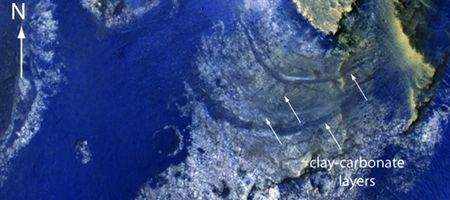NASA’s Mars Reconnaissance Orbiter (MRO) has found evidence that McLaughlin Crater once contained a lake fed by flowing groundwater.

The crater is 57 miles across and 1.4 miles deep – and, it now appears, has layered, flat rocks at the bottom contain carbonate and clay minerals that form in the presence of water.
The team found the minerals using the Compact Reconnaissance Imaging Spectrometer for Mars (CRISM) on the Mars Reconnaissance Orbiter (MRO).
McLaughlin lacks large inflow channels, but small channels originating within the crater wall end near a level that could have marked the surface of a lake.
Together, these observations suggest that the carbonates and clay were created in a groundwater-fed lake within the closed basin of the crater. It’s even possible that both the crater interior and the underground zone contributing the water could have been potential habitats for life.
“Taken together, the observations in McLaughlin Crater provide the best evidence for carbonate forming within a lake environment instead of being washed into a crater from outside,” says Joseph Michalski of the Planetary Science Institute in Tucson.
McLaughlin Crater sits at the low end of a slope several hundreds of miles long on the western side of the Arabia Terra region of Mars. On Earth, groundwater-fed lakes are usually found at low elevations, supporting the idea that this could be one.
“This new report and others are continuing to reveal a more complex Mars than previously appreciated, with at least some areas more likely to reveal signs of ancient life than others,” says MRO project scientist Rich Zurek.






